


 |
 |
 |
|
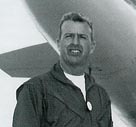 |
In memory of NASA Test Pilot Joe Walker and Air Force Maj. Carl Cross | 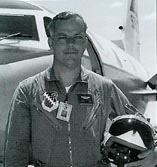 |
| NASA Test Pilot Joe Walker | Air Force Maj. Carl Cross |
XB-70 222 had undergone a night of preflight checks by flight test ground support. Technicians and engineers were busy making last minute checks while the big fuel trucks topped off the tanks for today's flight. The mission today was a photo and publicity flight with four other aircraft fitted with General Electric Engines. At the controls for today's flight were North American's Chief Test Pilot Al White and Air Force Major Carl Cross.
The XB-70 was to take off and perform a short series of flight test cards and then meet with the other four aircraft over the ocean just off Santa Barbara Coast line. A last look at the telemetry for all systems GO is made with the pilots on board when completing their cockpit checkout.
The crew module was a first in bomber design to have escape capsules for each pilot and an environmental controlled cabin that provided shirtsleeve comfort. A part of the pre-flight check was an exercise for each pilot to move his seat from his shirtsleeve position at the controls back into the escape capsule and close its clamshell. A pressurized gas cylinder provided assistance to move the seat into the capsule under high G forces. At this position the pilot(s) could independently jettison their capsule through an escape hatch that would be blown off as the ejection sequence began. The capsule would automatically deploy a parachute at the proper altitude to take each one safely to the ground.
To insure that primary data would be available in any emergency involving capsule ejection a flight test switch had been installed on the clamshell to turn on all data recorders when the shell was closed. [The significance of introducing this information in this story is that although the switch was for data purpose it would have let the Flight Test Team know which if not both of the pilots escaped from the aircraft. Because the switch was not activated in this incidence it left the flight team in question as to which pilot had escaped.]
 |
 |
It was a balmy day; slightly overcast but clear at flight altitude with very little turbulence. The aircraft had taken off and had been up for over half hour. They were now aligning their formation approach coming in from the coast and headed for the Mojave Desert. The flight test team was at the control center watching their assigned systems from the telemetry data coming in from the aircraft. The Lear Jet hired for the photograph was closing in to catch the formation of the XB-70 with two aircraft flying adjacent on each side.
 |
 |
The first announcement from the chase plane was that it would be a few moments before the procedure would begin. Joe Walker flying a F-104 was on right wing and in tight position. His aircraft was meeting some turbulence from off the XB-70 wing and he was trying to hold his position.
(Author's note: At the Beatty tracking station we routinely recorded the communications channel on a Fisher tape recorder. Only moments before the Mid-air Joe Walker officially notified mission control that he was encountering turbulence. He further stated for the record that he opposed this mission as it was too dangerous and had no scientific value. [The purpose of the mission was to provide General Electric, the manufacturer of the engines for the planes in formation, a photo for the cover of their brochures to be presented at an upcoming shareholders' meeting] Immediately after the crash, Mr. Bill Houck, the NASA monitor at our station, requested I give him the tape for dispatch to NASA at Dryden.)
 |
 |
 |
The F-104 Starfighter flown by Test Pilot Walker and two other supersonic jets, one flown by Air Force Col. Joseph F. Cotton, had closed their formation for the photo shoot when suddenly the collision occurred. Joe Walker's F-104 was in flames just after impact with the XB-70, both vertical stabilizers have been sheared off of the XB-70.
 |
 |
Some close to the investigation of the crash believed that if Walker got in so close as bring the tail up under the XB-70 wing, the result would be a rapid pitch up. The reason being, the effectiveness of the F-104 tail was neutralized and the F-104 aircraft would normally pitch up. With that, the left wing of the F-104 struck the XB-70 wing causing the pitch and roll across the top to continue or accelerate. Walker had not yet flown the XB-70, and was scheduled for the next day. Consequently, he had not experienced the remarkably rapid acceleration capabilities of the Valkyrie.
NASA's Director of Biological research (Major Roman, M.D.), who was the investigating doctor at the site, reported that Walker's F-104 was inverted as it passed across the top of the XB-70 and struck the XB-70 vertical tails and that the vertical stabilizer of the XB-70 had split Walker's cockpit and flight-helmet in half.
Having slammed across the top of the bomber's tail assembly --- damaging one of the tail vertical stabilizers and breaking off the other --- the Starfighter then cart wheeled and exploded into a plume of flame. XB-70 started a flat spin shortly after collision of the F-104 because of the missing vertical stabs and part of the wing. A hued vapor trail of JP-8 fuel spewed from the XB-70. Though the engines are still running, the craft did not catch fire.
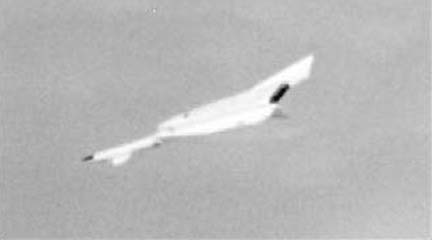 |
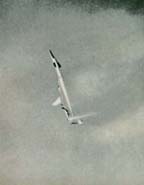 |
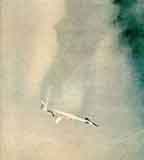 |
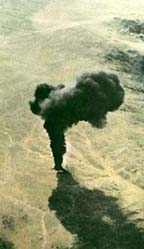 |
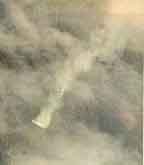 |
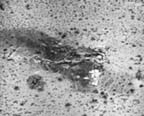 |
Without warning came the cry from Colonel Joe Cotton, "Mid Air, Mid Air".. "You got the verticals" ... "both the right and the left came off" ... "hold on Al you may go into a spin" ... "The B-70 is turning over on its side and starting to spin ... Bail Out Bail Out!!!".
Half dazed from an early morning arrival the flight test team came to the edge of their seats as they saw the strip chart data recorder spewing ink as pins shifted erratically from a normal tracking position.
"What the hell was that?" Cotton in his F-104 chase plane begins ordering the other planes to stay clear of the area. Parts from the XB-70 were tearing loose and twirling out as it continued to pick up speed in its flat spin to the ground. Half the left wing had separated from the XB-70 and with other parts falling in a funnel of debris.
Walkers plane had burst into flames behind the XB-70. Cotton again yells, "I see no Chute Bail - Out Bail Out"!
The plane had now lost approximately 10,000 ft., and no one had got out. Suddenly Cotton yells, "There's a chute. I see one chute; stay clear of that wing; one chute is gong down".
Tower has been pounding the radio channel to give them the position where the XB-70 is going in, "This is Mission Control, give us a position of the crash site".
Finally after Joe had collected himself from the anxiety to get the men out of the XB-70 and clear the area, he announces the expected position of the crash site. The plane had impacted near "Three Sisters" a few miles from Barstow, California. It was burning from the tail section with the flames moving to the nose of the aircraft.
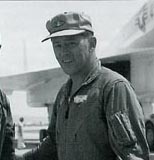 Al White's ejection capsule landed a few thousand feet away from the XB-70. Major Cross didn't make it out of the XB-70. Al White made it but had to be removed from the capsule and flown to the Edwards Hospital where he stayed a few days to recover from bruises and a back injury. His butt had made a perfect impression in the metal seat of the capsule.
Al White's ejection capsule landed a few thousand feet away from the XB-70. Major Cross didn't make it out of the XB-70. Al White made it but had to be removed from the capsule and flown to the Edwards Hospital where he stayed a few days to recover from bruises and a back injury. His butt had made a perfect impression in the metal seat of the capsule.
It was later learned from Al what a tragedy he had gone through. His story began when he first felt the impact of Walker's plane roll into the vertical stabilizers. His immediate reaction was to get his seat into the escape capsule. This was accomplished in a matter of seconds, as training for the escape had become a routine reaction. In closing the clam he had accidentally tucked his fist in the hollow of his armpit and his elbow was protruding in the path of the clamshell closure. It was tight quarters and he struggled to free his arm from the weight of the clam hood.
He saw that Major Cross was still leaning forward in his seat at the controls. The G forces were so high from the spin of the aircraft he was unable to move. Something was wrong with his seat. It had not moved back to his capsule. He had waited too long, and the G forces had built up beyond the operational ability of the seat retraction mechanism. [It was later learned that diaphragm in the seat retraction cylinder had ruptured under high loads created from the G forces of the aircraft spin; this could have been eight times its normal operating range; Cross had waited to long.]
What can I do for this guy was all Al could think of for a few moments. The G loads from the spin were building up fast. White knew he could not get to Major Cross to help him and if he could not get his elbow into the capsule he would lose his arm in the ejection of the seat. During these moments the Bomber had lost approximately 10,000 ft altitude. Forcing his closed hand out of the armpit, he struggled and finally freed his arm with little time left to hit the ejection switch.
The clamshell closed hard from the power of the thrust as it lifted from the aircraft. [NO signal came through the telemetry system to indicate Al's seat was the one that left, confusion lead to believe Cross-had made it out.]. Al's mind was in a flurry, his thoughts were on Cross and his own chances of being hit by the debris. He lost memory of the capsule procedure to deploy the air bag under the capsule. This cost him his hard bounce off the ground. The bottom of the capsule was equipped with an air bag (something like that in a car) and it needed to be energized by the occupant to be inflated to reduce the impact when the capsule hit the ground.
The results of the crash -- Joe Walker's F-104 Horizontal tail shows impact and scratch marks. Walker's F 104 was the only plane that struck the XB-70. In the flight formation the XB-70 outer wings were folded down. Walker was using the engine inlet ramp and the wing leading edge of the XB-70 as a reference for his position in the formation. He reportedly commented he was getting some turbulence from the wing and was trying to hold his position.
The horizontal stabilizer on the F-104 he was flying is mounted at the top of the vertical stabilizer. From the evidence of the scratch indentations of his horizontal stabilizer it had come in contact twice with the leading edge of the XB-70 outer wing. First it touched and then made a solid '˜S' scratch that catapulted his plane over the back of the XB-70, shearing both the vertical stabilizers and then bouncing off the left wing of the XB-70. His plane became an instant burning ember behind the XB-70. Amazingly the XB-70 did not burst into flames as its fuel cells were also ruptured and were losing JP 8 in a dense fog out of the aircraft. Normal Jet fuel for the F-104 is JP-4; much more flammable (higher combustion ratio than JP-8) and was the reason the fuel from the XB-70 did not ignite in the air.]
What went wrong on this flight was possibly a vortex air stream generated by the big aircraft that sucked Walkers F-104 into the wing of the XB-70. In any case, we lost a $4 billion plane and two veteran pilots in a mission whose purpose was to obtain a photo for a corporate brochure.
Click on images to enlarge
|
Special thanks to NASA and Tony Landis for the photos of the midair and crash of the XB-70 and Joe Walker's F-104 depicted in a slide show of the crash sequence. Also for editing hints by Don Mallick who flew with Walker on a number of occasions, sharing cross country flights in a T-33 and flying each other's wing in F-104s.
|
|
Carl's wife, Margaret Childers Cross, passed away ten years ago and is buried beside him at the Forest Hills Cemetery in Chattanooga, Tennessee. Carl's mother, aged 99, passed away and was buried in Chattanooga TN on May 9, 2005. Carl and Margaret's daughters LuAnn and Karen also live in Chattanooga. Carl has three grandchildren from his daughter, Karen. Carl also has a son Jimmy Ray Cross of Ringgold, Georgia. He is the half brother to Karen Cross and the late Luann Cross. Carl has two granddaughters Deanna and Lori Cross, and 6 great grandchildren. Lori and Patrick Bowers have 5 children together, Ellie, Joey, Frannie, Penny, and Lovie. Lori's sister Deanna has one son Gabe. Carl's sister, June and Carl's brother Edwin (Ed) live in Cleveland, Tennessee. Carl's nephew, David Payne lives in Escondido, California. Alan, another of Carl's nephews received his private pilot license about 1985 and proudly wears his uncle's Air Force wings.
1-23-2012 update by Gene and June Payne
Pneumonia took Carl's oldest daughter's life several years ago, and her request her ashes were strewn over a favorite spot of hers in the Great Smokey Mountain. There are three new additions to the family. Carl would be proud to know that he has three great grandchildren. Karen's daughter has two children -- a girl and a boy -- and son Andrew now has a daughter. They all still reside in Chattanooga.
We wish to thank Gene & June Payne, Hoyle D. Hyberger, Lori Cross-Bowers and the rest of the family for keeping us informed about the family of our aviation brother, Maj. Carl Cross.
MEMORIAL DAY - 2004
|
T.D. Barnes, in white, joined by friends, Steve Nutt and Tim Uhlenbusch, paying respect to Joe Walker and Carl Cross with whom he worked until that haunting day of the Midair almost 40 years ago.

Memorial constructed by Jeremy Krans and friends October 2015
 |
 |
 |